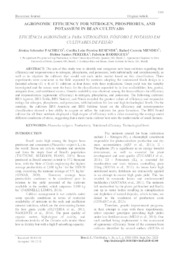Agronomic efficiency for nitrogen, phosphorus, and potassium in bean cultivars.
Agronomic efficiency for nitrogen, phosphorus, and potassium in bean cultivars.
Autoria: PACHECO, J. S.; RESENDE, C. L. P.; MENDES, R. C.; PEREIRA, H. S.; RODRIGUES, F.
Resumo: The aim of this study was to identify and categorize new bean cultivars regarding their efficiency and responsiveness to nitrogen, phosphorus, and potassium, both individually and simultaneously, as well as to stipulate the cultivars that would suit each niche market based on this classification. Three experiments were conducted in the field separated by nutrients adopting the randomized block design in a factorial scheme (11 x 4) of 11 cultivars in four doses with three replications. Grain yield was the variable investigated and the means were the basis for the classification separated by in four availabilities: low, partial, adequate dose, and nutritional excess. Genetic variability was observed among the bean cultivars for efficiency and responsiveness (agronomic efficiency) to nitrogen, phosphorus, and potassium. The following cultivars: BRS Agreste, BRS Estilo, BRS Notável, and Pérola revealed the greatest values of efficiency and responsive ratings for nitrogen, phosphorus, and potassium, with indications for low and high technological levels. On the contrary, the cultivars BRS Ametista and BRS Sublime based on the efficiency and non-responsive classification showed a low ability to acquire or utilize the nutrients for grain formation. The BRS Pontal cultivar for all three nutrients displayed a high degree of efficiency with a value exceeding the average under different conditions of stress, suggesting that a more rustic cultivar best suits the market niche of small farmers.
Ano de publicação: 2020
Tipo de publicação: Artigo de periódico
Unidade: Embrapa Arroz e Feijão
Palavras-chave: Beans, Eficiência Nutricional, Feijão, Fósforo, Nitrogênio, Phaseolus Vulgaris, Potássio, Produtividade, Soil productivity, Technological change
Observações
1 - Por padrão são exibidas publicações dos últimos 20 anos. Para encontrar publicações mais antigas, configure o filtro ano de publicação, colocando o ano a partir do qual você deseja encontrar publicações. O filtro está na coluna da esquerda na busca acima.
2 - Para ler algumas publicações da Embrapa (apenas as que estão em formato ePub), é necessário ter, no celular ou computador, um desses softwares gratuitos. Sistemas Android: Google Play Livros; IOS: iBooks; Windows e Linux: software Calibre.
Acesse outras publicações
Acesse a Base de Dados da Pesquisa Agropecuária (BDPA) para consultar o acervo completo das bibliotecas da Embrapa.

